SUBARU LEGACY 1999 Service Owner's Guide
Manufacturer: SUBARU, Model Year: 1999, Model line: LEGACY, Model: SUBARU LEGACY 1999Pages: 1456, PDF Size: 59.93 MB
Page 31 of 1456
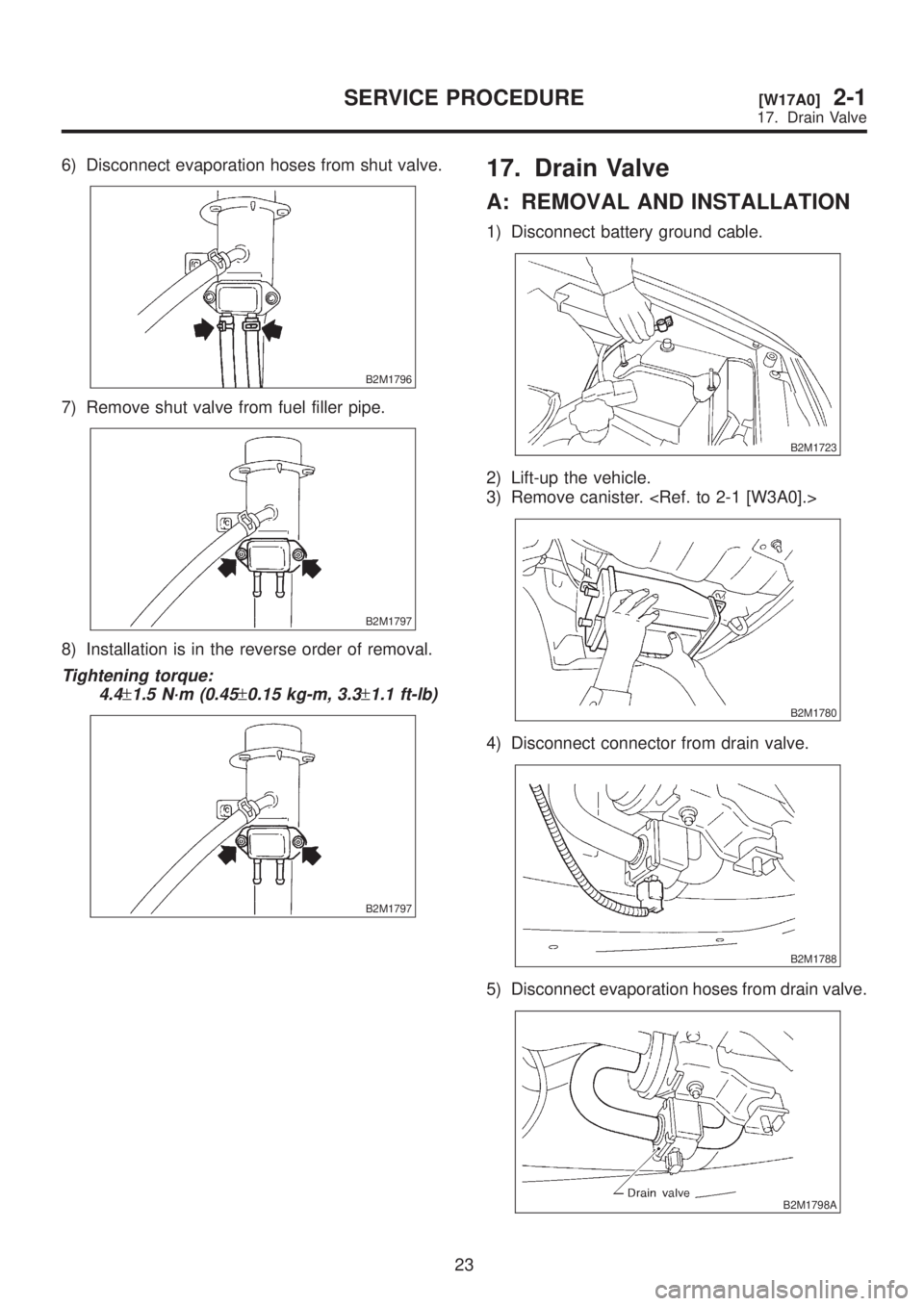
6) Disconnect evaporation hoses from shut valve.
B2M1796
7) Remove shut valve from fuel filler pipe.
B2M1797
8) Installation is in the reverse order of removal.
Tightening torque:
4.4
±1.5 N´m (0.45±0.15 kg-m, 3.3±1.1 ft-lb)
B2M1797
17. Drain Valve
A: REMOVAL AND INSTALLATION
1) Disconnect battery ground cable.
B2M1723
2) Lift-up the vehicle.
3) Remove canister.
B2M1780
4) Disconnect connector from drain valve.
B2M1788
5) Disconnect evaporation hoses from drain valve.
B2M1798A
23
[W17A0]2-1SERVICE PROCEDURE
17. Drain Valve
Page 32 of 1456
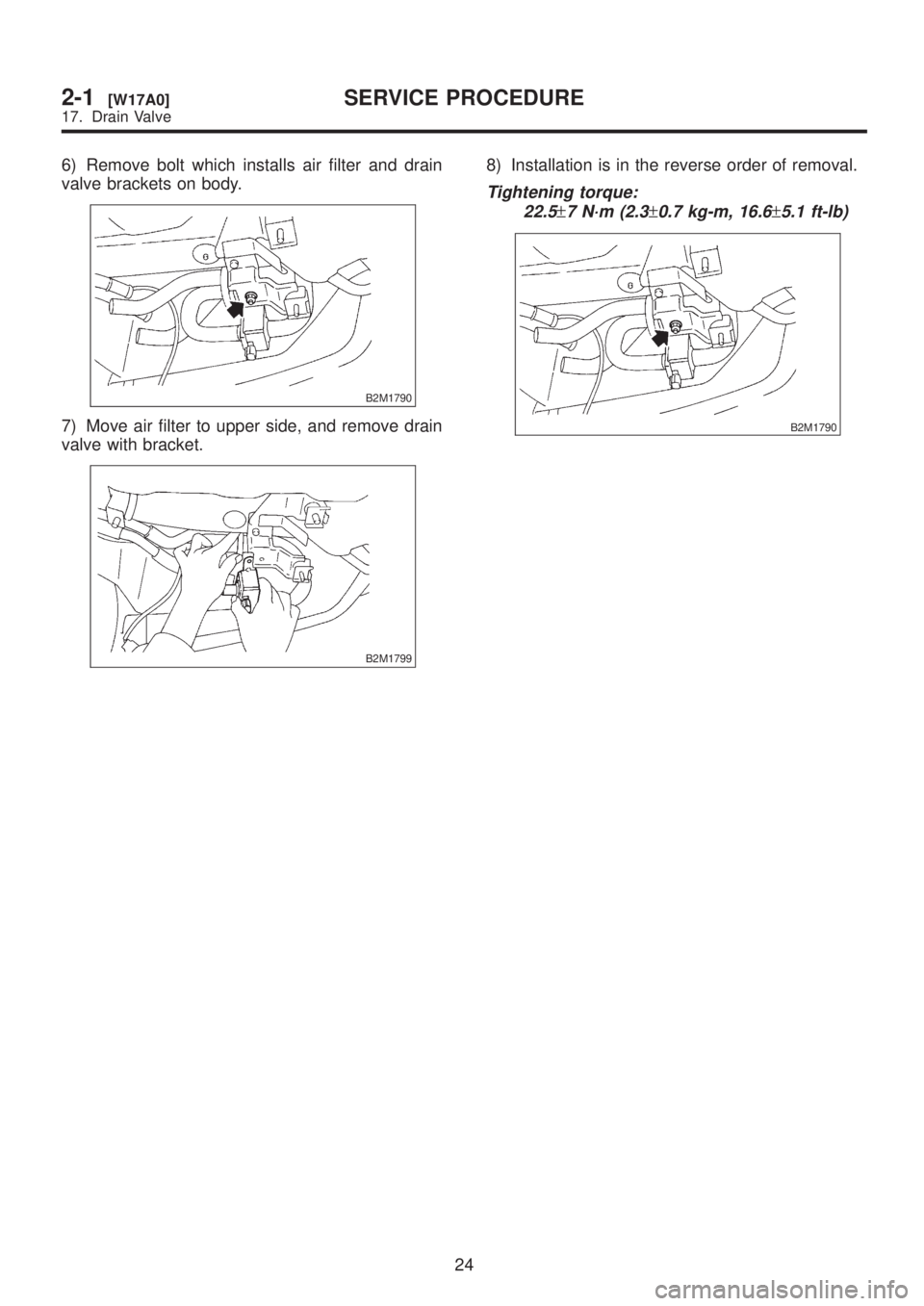
6) Remove bolt which installs air filter and drain
valve brackets on body.
B2M1790
7) Move air filter to upper side, and remove drain
valve with bracket.
B2M1799
8) Installation is in the reverse order of removal.
Tightening torque:
22.5
±7 N´m (2.3±0.7 kg-m, 16.6±5.1 ft-lb)
B2M1790
24
2-1[W17A0]SERVICE PROCEDURE
17. Drain Valve
Page 33 of 1456
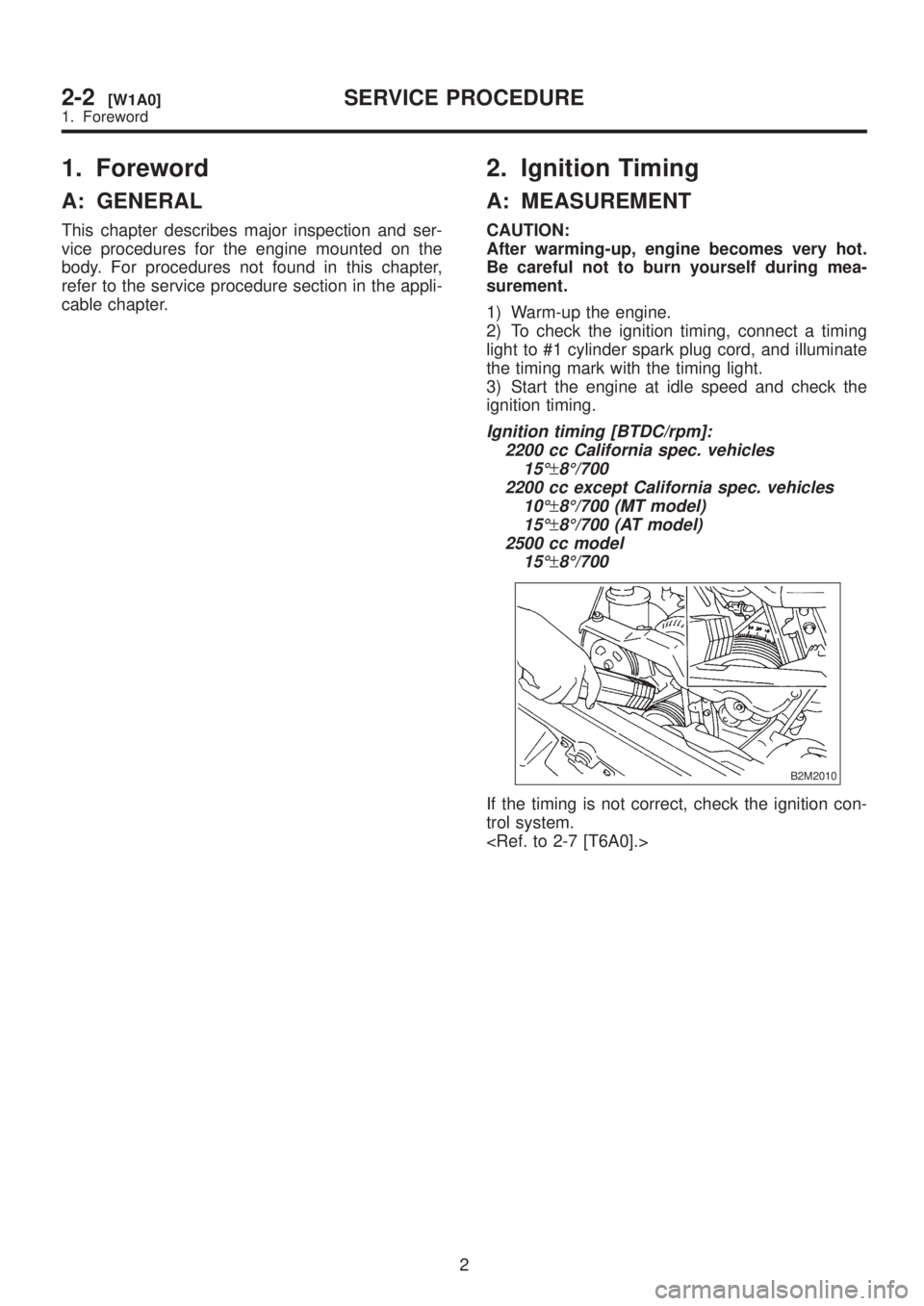
1. Foreword
A: GENERAL
This chapter describes major inspection and ser-
vice procedures for the engine mounted on the
body. For procedures not found in this chapter,
refer to the service procedure section in the appli-
cable chapter.
2. Ignition Timing
A: MEASUREMENT
CAUTION:
After warming-up, engine becomes very hot.
Be careful not to burn yourself during mea-
surement.
1) Warm-up the engine.
2) To check the ignition timing, connect a timing
light to #1 cylinder spark plug cord, and illuminate
the timing mark with the timing light.
3) Start the engine at idle speed and check the
ignition timing.
Ignition timing [BTDC/rpm]:
2200 cc California spec. vehicles
15É
±8É/700
2200 cc except California spec. vehicles
10É
±8É/700 (MT model)
15É
±8É/700 (AT model)
2500 cc model
15É
±8É/700
B2M2010
If the timing is not correct, check the ignition con-
trol system.
2
2-2[W1A0]SERVICE PROCEDURE
1. Foreword
Page 34 of 1456
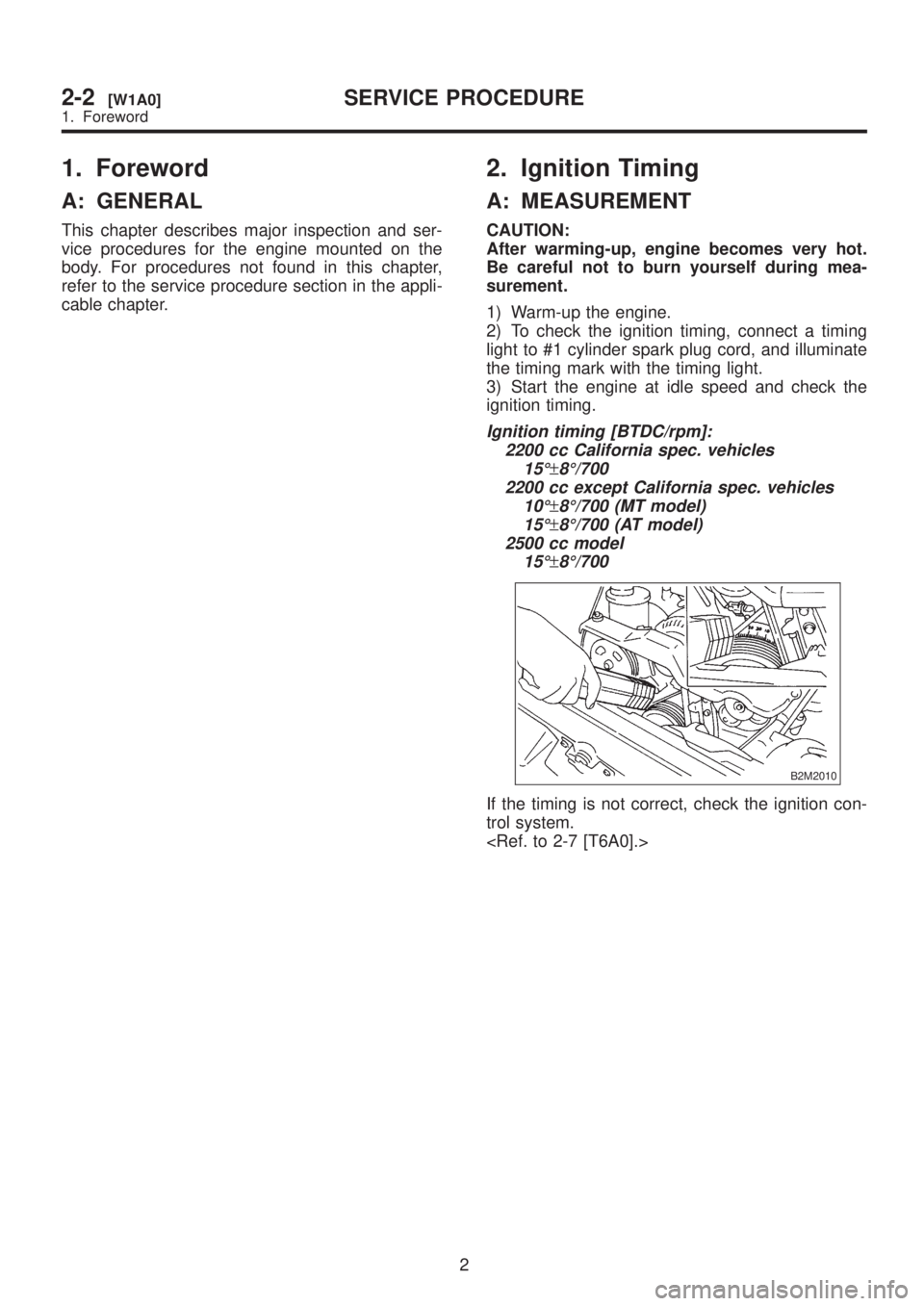
1. Foreword
A: GENERAL
This chapter describes major inspection and ser-
vice procedures for the engine mounted on the
body. For procedures not found in this chapter,
refer to the service procedure section in the appli-
cable chapter.
2. Ignition Timing
A: MEASUREMENT
CAUTION:
After warming-up, engine becomes very hot.
Be careful not to burn yourself during mea-
surement.
1) Warm-up the engine.
2) To check the ignition timing, connect a timing
light to #1 cylinder spark plug cord, and illuminate
the timing mark with the timing light.
3) Start the engine at idle speed and check the
ignition timing.
Ignition timing [BTDC/rpm]:
2200 cc California spec. vehicles
15É
±8É/700
2200 cc except California spec. vehicles
10É
±8É/700 (MT model)
15É
±8É/700 (AT model)
2500 cc model
15É
±8É/700
B2M2010
If the timing is not correct, check the ignition con-
trol system.
2
2-2[W1A0]SERVICE PROCEDURE
1. Foreword
Page 35 of 1456
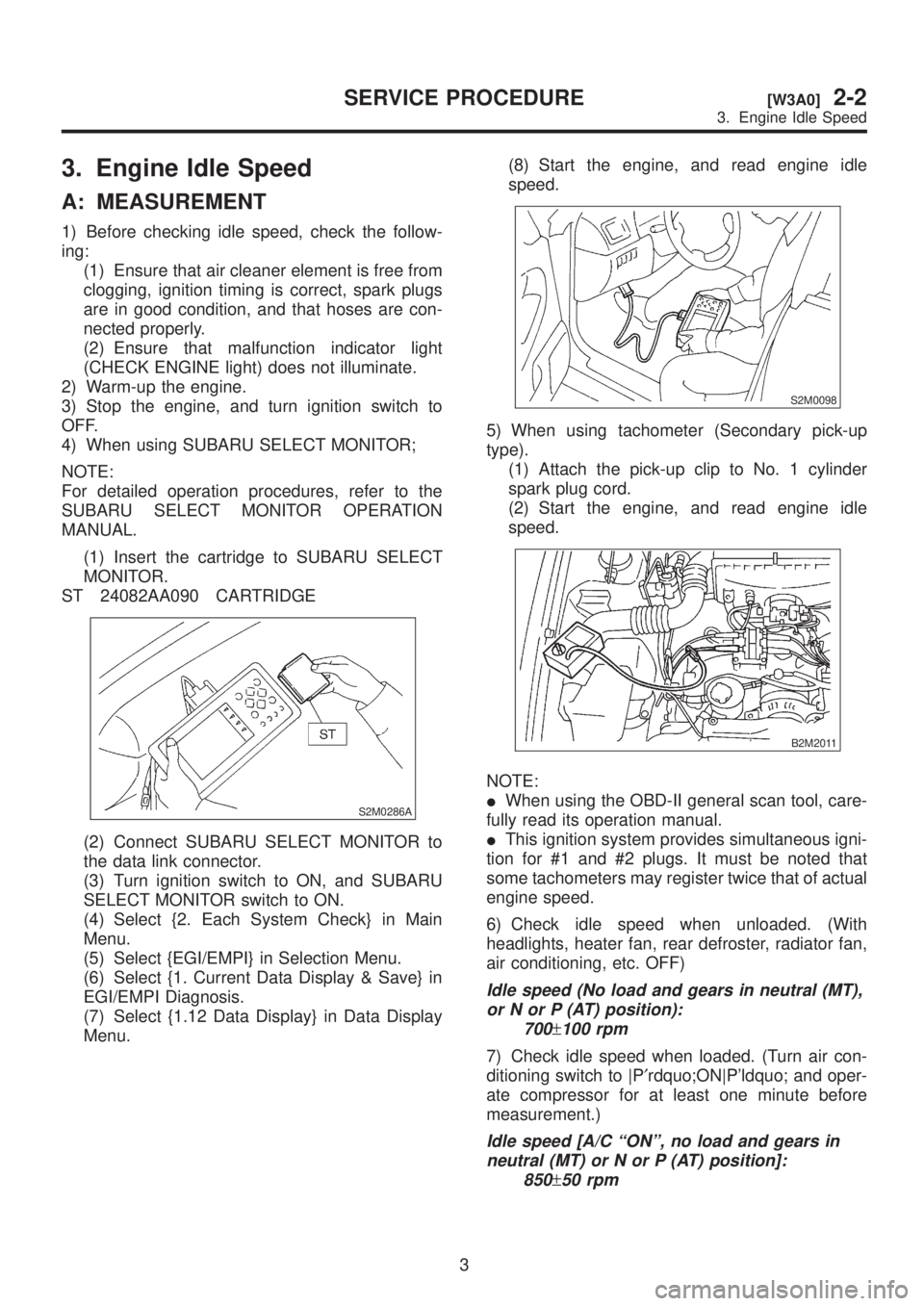
3. Engine Idle Speed
A: MEASUREMENT
1) Before checking idle speed, check the follow-
ing:
(1) Ensure that air cleaner element is free from
clogging, ignition timing is correct, spark plugs
are in good condition, and that hoses are con-
nected properly.
(2) Ensure that malfunction indicator light
(CHECK ENGINE light) does not illuminate.
2) Warm-up the engine.
3) Stop the engine, and turn ignition switch to
OFF.
4) When using SUBARU SELECT MONITOR;
NOTE:
For detailed operation procedures, refer to the
SUBARU SELECT MONITOR OPERATION
MANUAL.
(1) Insert the cartridge to SUBARU SELECT
MONITOR.
ST 24082AA090 CARTRIDGE
S2M0286A
(2) Connect SUBARU SELECT MONITOR to
the data link connector.
(3) Turn ignition switch to ON, and SUBARU
SELECT MONITOR switch to ON.
(4) Select {2. Each System Check} in Main
Menu.
(5) Select {EGI/EMPI} in Selection Menu.
(6) Select {1. Current Data Display & Save} in
EGI/EMPI Diagnosis.
(7) Select {1.12 Data Display} in Data Display
Menu.(8) Start the engine, and read engine idle
speed.
S2M0098
5) When using tachometer (Secondary pick-up
type).
(1) Attach the pick-up clip to No. 1 cylinder
spark plug cord.
(2) Start the engine, and read engine idle
speed.
B2M2011
NOTE:
IWhen using the OBD-II general scan tool, care-
fully read its operation manual.
IThis ignition system provides simultaneous igni-
tion for #1 and #2 plugs. It must be noted that
some tachometers may register twice that of actual
engine speed.
6) Check idle speed when unloaded. (With
headlights, heater fan, rear defroster, radiator fan,
air conditioning, etc. OFF)
Idle speed (No load and gears in neutral (MT),
or N or P (AT) position):
700
±100 rpm
7) Check idle speed when loaded. (Turn air con-
ditioning switch to |P¢rdquo;ON|P'ldquo; and oper-
ate compressor for at least one minute before
measurement.)
Idle speed [A/C ªONº, no load and gears in
neutral (MT) or N or P (AT) position]:
850
±50 rpm
3
[W3A0]2-2SERVICE PROCEDURE
3. Engine Idle Speed
Page 36 of 1456
![SUBARU LEGACY 1999 Service Owners Guide CAUTION:
Never rotate idle adjusting screw. If idle speed
is out of specifications, refer to General On-
board Diagnosis Table under ª2-7 On-Board
Diagnostics II Systemº.
<Ref. to 2-7 [T6A0].>4. Eng SUBARU LEGACY 1999 Service Owners Guide CAUTION:
Never rotate idle adjusting screw. If idle speed
is out of specifications, refer to General On-
board Diagnosis Table under ª2-7 On-Board
Diagnostics II Systemº.
<Ref. to 2-7 [T6A0].>4. Eng](/img/17/57435/w960_57435-35.png)
CAUTION:
Never rotate idle adjusting screw. If idle speed
is out of specifications, refer to General On-
board Diagnosis Table under ª2-7 On-Board
Diagnostics II Systemº.
A: MEASUREMENT
1. 2200 cc MODEL
1) After warming-up the engine, turn ignition
switch to OFF.
2) Make sure that the battery is fully charged.
3) Remove all the spark plugs.
4) Disconnect connectors from fuel injectors.
5) Fully open throttle valve.
6) Check the starter motor for satisfactory perfor-
mance and operation.
7) Hold the compression gauge tight against the
spark plug hole.
CAUTION:
When using a screw-in type compression
gauge, the screw (put into cylinder head spark
plug hole) should be less than 18 mm (0.71 in)
long.
8) Crank the engine by means of the starter motor,
and read the maximum value on the gauge when
the pointer is steady.
G2M0098
9) Perform at least two measurements per
cylinder, and make sure that the values are correct.
Compression (200 Ð 300 rpm and fully open
throttle):
Standard;
1,079 Ð 1,275 kPa (11.0 Ð 13.0 kg/cm
2,
156 Ð 185 psi)
Limit;
883 kPa (9.0 kg/cm
2, 128 psi)
Difference between cylinders;
196 kPa (2.0 kg/cm
2, 28 psi)
4
2-2[W4A1]SERVICE PROCEDURE
4. Engine Compression
Page 37 of 1456
![SUBARU LEGACY 1999 Service Owners Guide CAUTION:
Never rotate idle adjusting screw. If idle speed
is out of specifications, refer to General On-
board Diagnosis Table under ª2-7 On-Board
Diagnostics II Systemº.
<Ref. to 2-7 [T6A0].>4. Eng SUBARU LEGACY 1999 Service Owners Guide CAUTION:
Never rotate idle adjusting screw. If idle speed
is out of specifications, refer to General On-
board Diagnosis Table under ª2-7 On-Board
Diagnostics II Systemº.
<Ref. to 2-7 [T6A0].>4. Eng](/img/17/57435/w960_57435-36.png)
CAUTION:
Never rotate idle adjusting screw. If idle speed
is out of specifications, refer to General On-
board Diagnosis Table under ª2-7 On-Board
Diagnostics II Systemº.
A: MEASUREMENT
1. 2200 cc MODEL
1) After warming-up the engine, turn ignition
switch to OFF.
2) Make sure that the battery is fully charged.
3) Remove all the spark plugs.
4) Disconnect connectors from fuel injectors.
5) Fully open throttle valve.
6) Check the starter motor for satisfactory perfor-
mance and operation.
7) Hold the compression gauge tight against the
spark plug hole.
CAUTION:
When using a screw-in type compression
gauge, the screw (put into cylinder head spark
plug hole) should be less than 18 mm (0.71 in)
long.
8) Crank the engine by means of the starter motor,
and read the maximum value on the gauge when
the pointer is steady.
G2M0098
9) Perform at least two measurements per
cylinder, and make sure that the values are correct.
Compression (200 Ð 300 rpm and fully open
throttle):
Standard;
1,079 Ð 1,275 kPa (11.0 Ð 13.0 kg/cm
2,
156 Ð 185 psi)
Limit;
883 kPa (9.0 kg/cm
2, 128 psi)
Difference between cylinders;
196 kPa (2.0 kg/cm
2, 28 psi)
4
2-2[W4A1]SERVICE PROCEDURE
4. Engine Compression
Page 38 of 1456
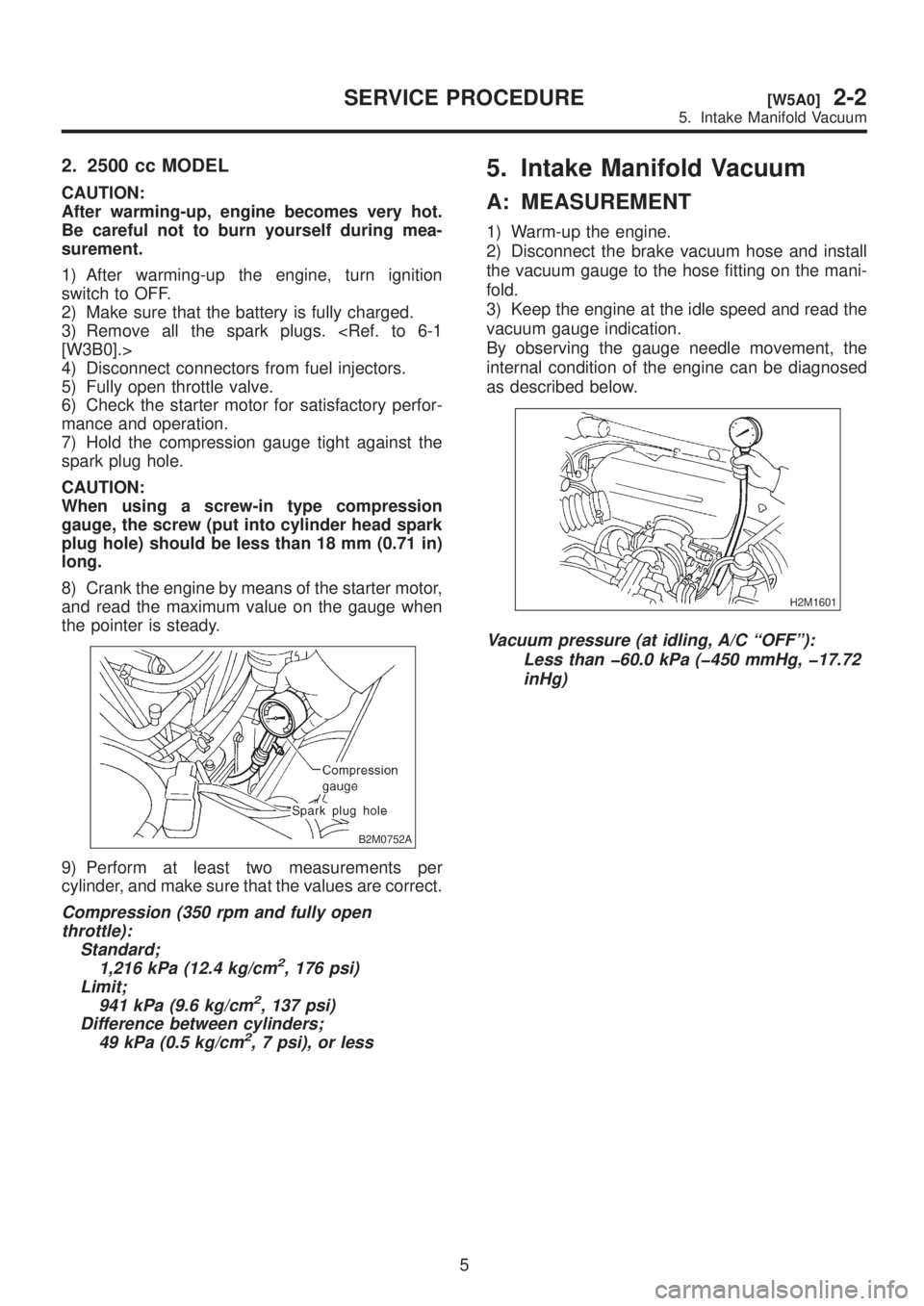
2. 2500 cc MODEL
CAUTION:
After warming-up, engine becomes very hot.
Be careful not to burn yourself during mea-
surement.
1) After warming-up the engine, turn ignition
switch to OFF.
2) Make sure that the battery is fully charged.
3) Remove all the spark plugs.
4) Disconnect connectors from fuel injectors.
5) Fully open throttle valve.
6) Check the starter motor for satisfactory perfor-
mance and operation.
7) Hold the compression gauge tight against the
spark plug hole.
CAUTION:
When using a screw-in type compression
gauge, the screw (put into cylinder head spark
plug hole) should be less than 18 mm (0.71 in)
long.
8) Crank the engine by means of the starter motor,
and read the maximum value on the gauge when
the pointer is steady.
B2M0752A
9) Perform at least two measurements per
cylinder, and make sure that the values are correct.
Compression (350 rpm and fully open
throttle):
Standard;
1,216 kPa (12.4 kg/cm
2, 176 psi)
Limit;
941 kPa (9.6 kg/cm
2, 137 psi)
Difference between cylinders;
49 kPa (0.5 kg/cm
2, 7 psi), or less
5. Intake Manifold Vacuum
A: MEASUREMENT
1) Warm-up the engine.
2) Disconnect the brake vacuum hose and install
the vacuum gauge to the hose fitting on the mani-
fold.
3) Keep the engine at the idle speed and read the
vacuum gauge indication.
By observing the gauge needle movement, the
internal condition of the engine can be diagnosed
as described below.
H2M1601
Vacuum pressure (at idling, A/C ªOFFº):
Less than þ60.0 kPa (þ450 mmHg, þ17.72
inHg)
5
[W5A0]2-2SERVICE PROCEDURE
5. Intake Manifold Vacuum
Page 39 of 1456
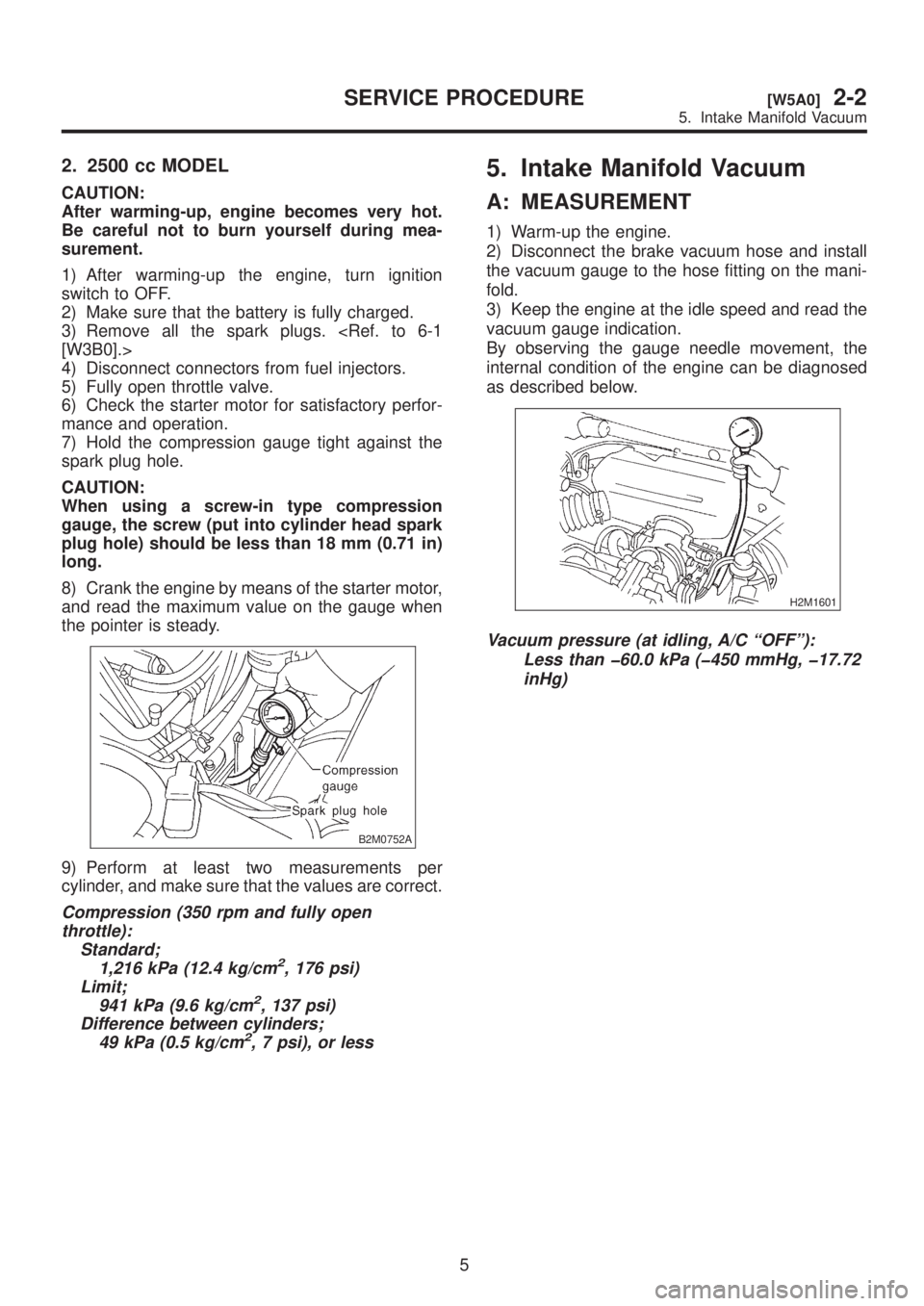
2. 2500 cc MODEL
CAUTION:
After warming-up, engine becomes very hot.
Be careful not to burn yourself during mea-
surement.
1) After warming-up the engine, turn ignition
switch to OFF.
2) Make sure that the battery is fully charged.
3) Remove all the spark plugs.
4) Disconnect connectors from fuel injectors.
5) Fully open throttle valve.
6) Check the starter motor for satisfactory perfor-
mance and operation.
7) Hold the compression gauge tight against the
spark plug hole.
CAUTION:
When using a screw-in type compression
gauge, the screw (put into cylinder head spark
plug hole) should be less than 18 mm (0.71 in)
long.
8) Crank the engine by means of the starter motor,
and read the maximum value on the gauge when
the pointer is steady.
B2M0752A
9) Perform at least two measurements per
cylinder, and make sure that the values are correct.
Compression (350 rpm and fully open
throttle):
Standard;
1,216 kPa (12.4 kg/cm
2, 176 psi)
Limit;
941 kPa (9.6 kg/cm
2, 137 psi)
Difference between cylinders;
49 kPa (0.5 kg/cm
2, 7 psi), or less
5. Intake Manifold Vacuum
A: MEASUREMENT
1) Warm-up the engine.
2) Disconnect the brake vacuum hose and install
the vacuum gauge to the hose fitting on the mani-
fold.
3) Keep the engine at the idle speed and read the
vacuum gauge indication.
By observing the gauge needle movement, the
internal condition of the engine can be diagnosed
as described below.
H2M1601
Vacuum pressure (at idling, A/C ªOFFº):
Less than þ60.0 kPa (þ450 mmHg, þ17.72
inHg)
5
[W5A0]2-2SERVICE PROCEDURE
5. Intake Manifold Vacuum
Page 40 of 1456
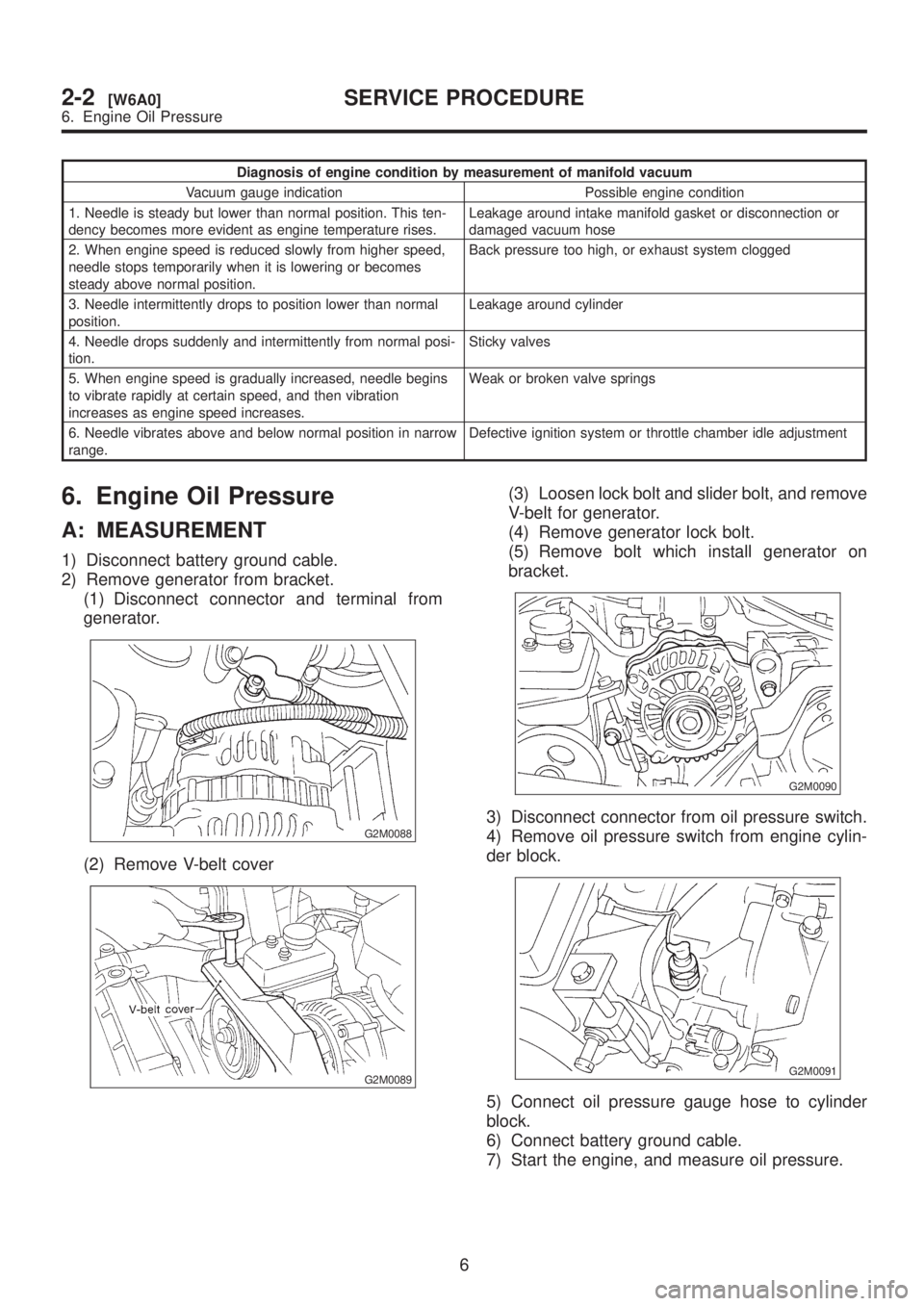
Diagnosis of engine condition by measurement of manifold vacuum
Vacuum gauge indication Possible engine condition
1. Needle is steady but lower than normal position. This ten-
dency becomes more evident as engine temperature rises.Leakage around intake manifold gasket or disconnection or
damaged vacuum hose
2. When engine speed is reduced slowly from higher speed,
needle stops temporarily when it is lowering or becomes
steady above normal position.Back pressure too high, or exhaust system clogged
3. Needle intermittently drops to position lower than normal
position.Leakage around cylinder
4. Needle drops suddenly and intermittently from normal posi-
tion.Sticky valves
5. When engine speed is gradually increased, needle begins
to vibrate rapidly at certain speed, and then vibration
increases as engine speed increases.Weak or broken valve springs
6. Needle vibrates above and below normal position in narrow
range.Defective ignition system or throttle chamber idle adjustment
6. Engine Oil Pressure
A: MEASUREMENT
1) Disconnect battery ground cable.
2) Remove generator from bracket.
(1) Disconnect connector and terminal from
generator.
G2M0088
(2) Remove V-belt cover
G2M0089
(3) Loosen lock bolt and slider bolt, and remove
V-belt for generator.
(4) Remove generator lock bolt.
(5) Remove bolt which install generator on
bracket.
G2M0090
3) Disconnect connector from oil pressure switch.
4) Remove oil pressure switch from engine cylin-
der block.
G2M0091
5) Connect oil pressure gauge hose to cylinder
block.
6) Connect battery ground cable.
7) Start the engine, and measure oil pressure.
6
2-2[W6A0]SERVICE PROCEDURE
6. Engine Oil Pressure